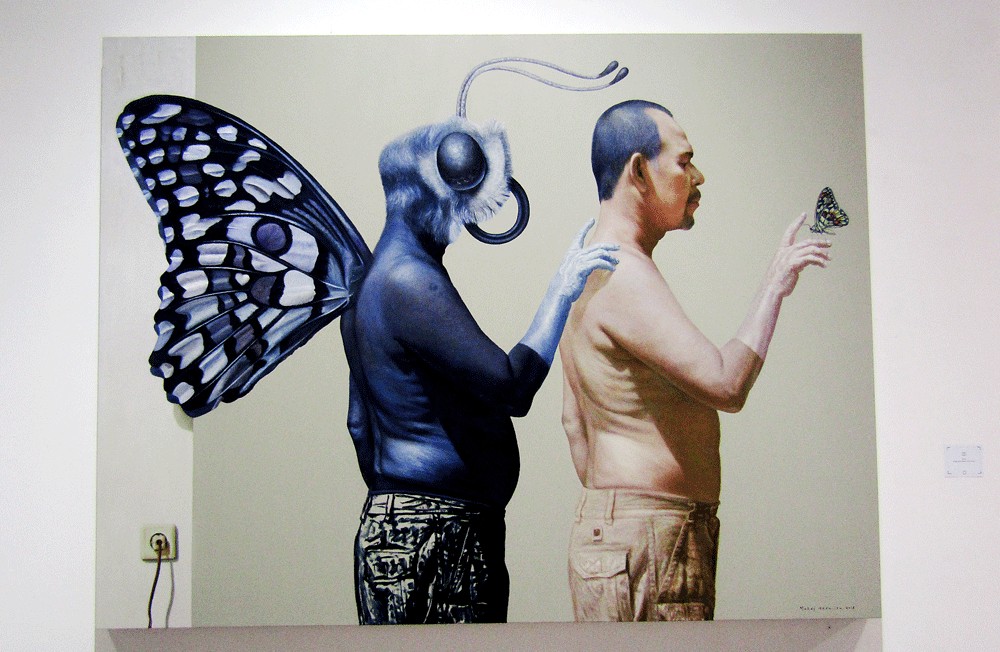‘Two Sides of the Medal’: Mahdi Abdullah’s exploration of dualism in life
Change Size
 The other side of me: Mahdi Abdullah’s painting Tamu (Guest) depicts the human and animalistic nature of man. (The Jakarta Post/Bambang Muryanto)
The other side of me: Mahdi Abdullah’s painting Tamu (Guest) depicts the human and animalistic nature of man. (The Jakarta Post/Bambang Muryanto)
T
em>The Two Sides of the Medal exhibition by Yogyakarta-based artist Mahdi Abdullah highlights dualism in life and the ordeals faced by women of his hometown Aceh during past military operations.
A large painting depicts the face of an old Acehnese woman who covers her right eye with her hand, with her left eye reflecting an image of an M16 assault gun.
The acrylic painting, titled Testimony by 58-year-old artist Mahdi Abdullah, shows her wrinkles and facial expression in detail — so much so that it looks like a photograph.
The old lady in the painting, Nyak Aman, a frequent model for Mahdi’s paintings, radiates peace, even though she lived in a time of violence.
“The Acehnese women bore witness to the prevailing violence in the province, but I also wish to reveal the widespread violence and terrorism in Java and Sulawesi,” Mahdi told The Jakarta Post on Oct. 1.
Testimony is one of the 17 works featured in Mahdi’s solo 19th solo exhibition at the Sangkring Art Project in Yogyakarta, which runs from Oct. 30 to Nov. 13. The exhibition, which depicts the dualistic aspects of human life, is curated by Mahdi himself.
“Without curators, I convey the whole picture,” said Mahdi, who moved to Yogyakarta after a tsunami destroyed his house in Aceh in 2004.
In Indonesia’s art scene, Mahdi is known as a painter who uses realism to expose his anxieties over the social realities he has witnessed, especially related to the life of the so-called common people.
The former journalist said not many people paid attention to dualism in life; black and white, heaven and earth, left and right, virtue and evil, visible and invisible. They serve as a “sign” to remind man of the choices he makes.
Mahdi’s painting titled Tamu (Guest), for instance, highlights the human and animalistic natures of a man. The painting shows a man with a butterfly perching on his finger. Behind him, a creature with a butterfly head and wings rests its right hand on the man’s shoulder.
“I choose butterflies because people here [in Java] believe that when a butterfly enters a house, it means a guest will come,” said Mahdi, who studied at the Indonesian Fine Art Academy (ASRI) in Yogyakarta as an audit student.
Mahdi criticizes some groups’ tendency of using religion to oppress women in his painting, Sound Up and Sound Down. Two loudspeakers are seen attached to a tall pole. Behind the speakers, a group of men scream at a veiled woman, who bends down and covers her face.
“I combine the situation I witnessed in Jakarta, where religious sermons broadcast through speakers disturbs local residents, and that in Aceh, where women become victims,” Mahdi added.
The painting cleverly depicts the opposing sides of reality. A mosque’s speaker is intended to convey a message on virtuous deeds, but it instead produces an adverse impact on people because it is too loud. In Aceh, the men preach about religious norms to gain power and oppress women.
In the exhibition, Mahdi also includes some works focusing on the violence in Aceh when it endured the government’s military operations between 1989 and 1998. Both the Indonesian Military (TNI) and Free Aceh Movement (GAM) committed violence during the period.
The dark side of Aceh is depicted in Chronology #15, Open and Shut, Fragrance of a Dream and The Smell of a Face Print, as well as an installation titled Dynamics of Top in Land of War.
In the installation, Mahdi presents five tops to symbolize a family of five. The tops are embellished with sketches of the life of the Acehnese people and the violence they face.
Rice, spices and paddy are scattered on a table. A motor on the table constantly spins the tops to signify that whatever happens, life keeps moving on.
The installation also includes a passage from novel Di Serambi Makkah (In Aceh) by Tasaro.
“It was heartrending to see old women crying [as] their houses were burned down. Their neighbors didn’t dare help for fear of having the same fate. Evacuees did not receive aid for weeks and slept in tents with palm roofs; they cooked just an ounce of rice per family. Crazy! I never imagined that such things could happen in Indonesia,” the passage reads.
Commenting on the exhibition, Werner Kraus from the Center for Southeast Asian Art said Mahdi’s creations spoke volumes about his life experiences and place of origin.
“Mahdi Abdullah […] had more than the ordinary share of disturbing experiences in his early life. After all, he was born and grew up in Aceh during a time of civil strife and natural disaster,” Kraus wrote in his essay.
According to art writer Anton Larenz, Mahdi’s excellent realist technique carries a tremendous persuasive power.
“It is an introspection, an inventory of his thoughts and feelings that he found inside. Sometimes they’re dreamy, poetic, sometimes mirroring fears and terror, leaving the plane of realism and opening almost surrealist dimensions,” Larenz said.









